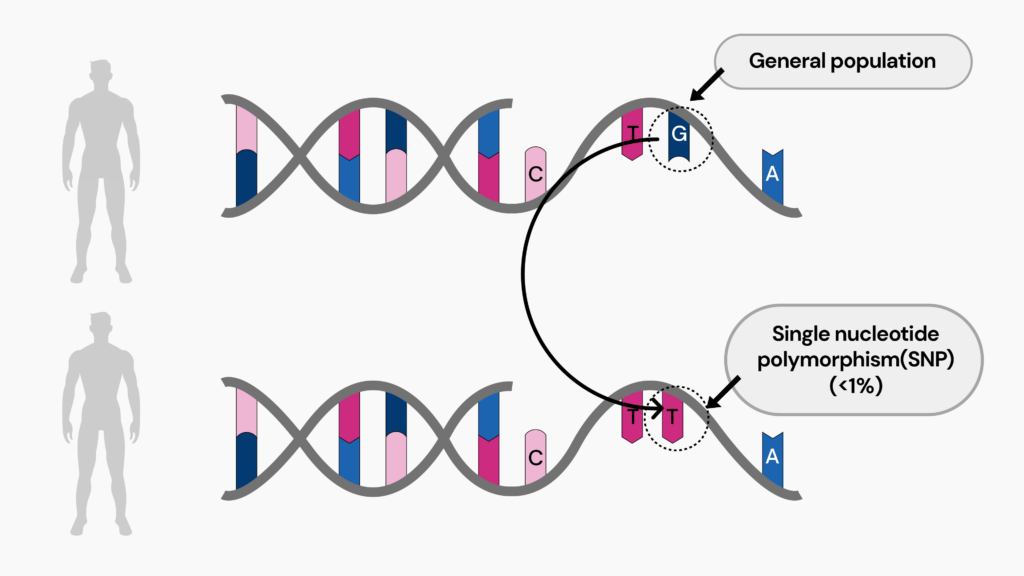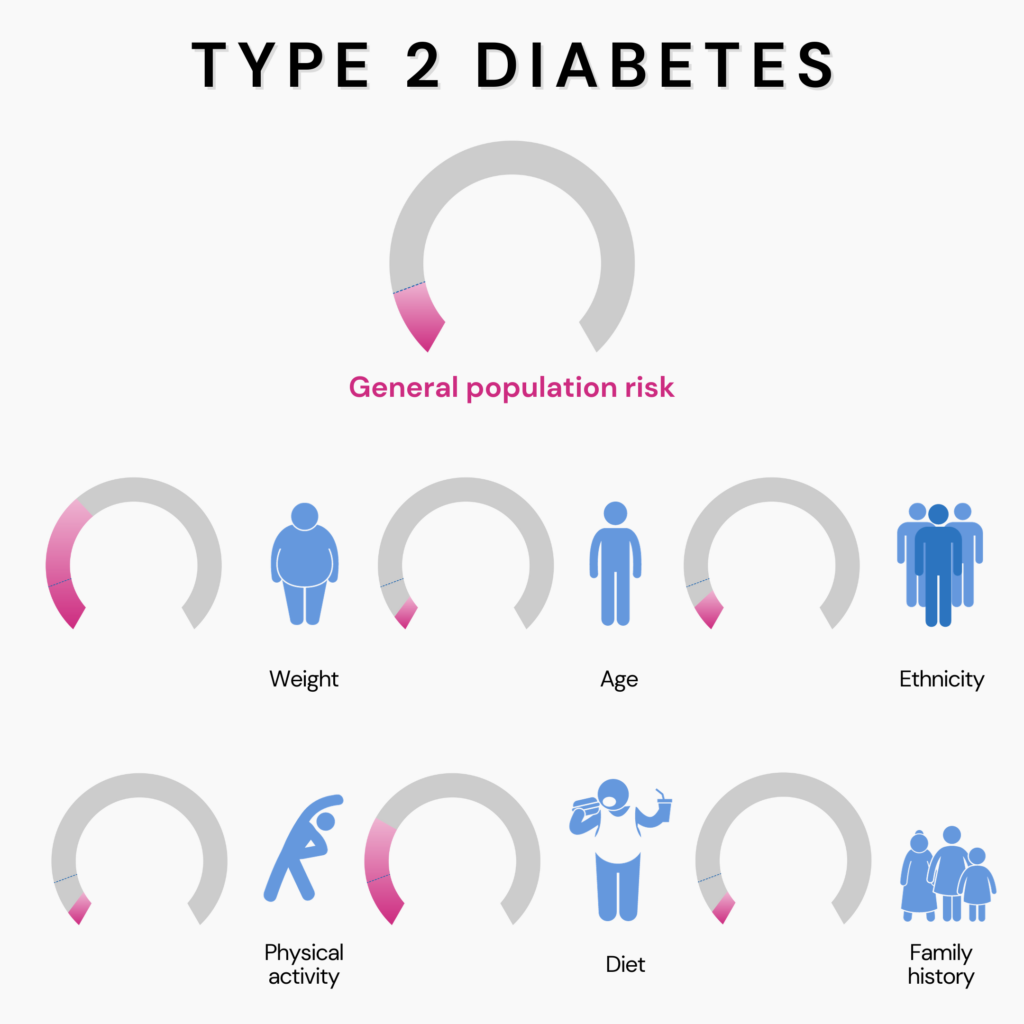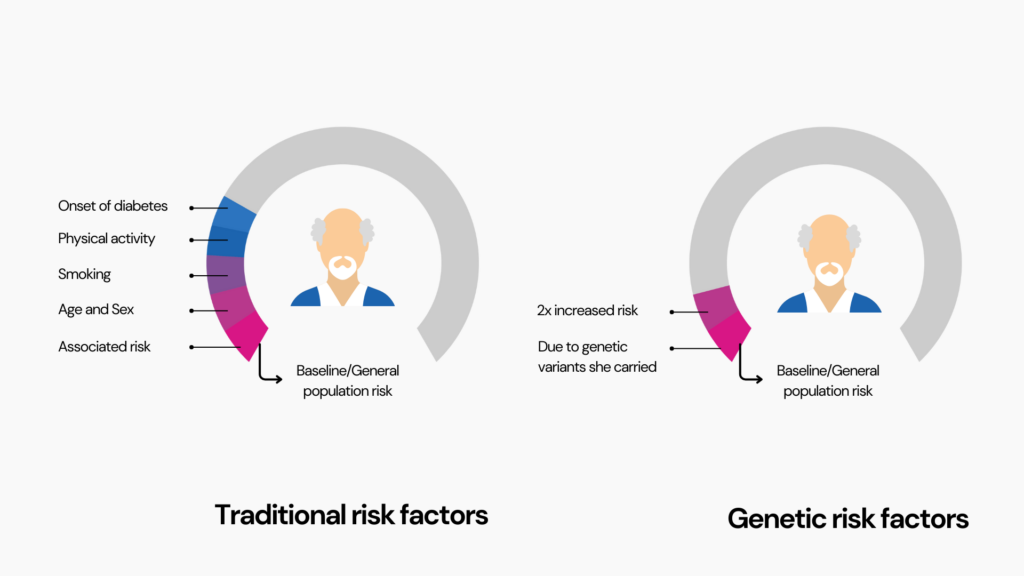Have you ever wondered why some people have blue eyes while others have brown? Or why some folks are more likely to get certain diseases? It's all about our genes, the instructions passed down from our parents, making us who we are. But not all genes are the same. Some have tiny differences, called genetic variants, in their code. These variants can change how a gene works and affect our appearance and health. Read on to explore genotyping, a way to find these genetic variants in an individual or a population. We will cover the definition and process of genotyping, its potential applications, and future implications for health and research.
Genetic ancestry tests are becoming increasingly popular. While your DNA can be used to learn about your roots, did you know that it can also reveal important things about your health risks and wellness aspects? This allows you to take proactive measures for health conditions, even before the symptoms appear, thereby preventing it. You can upload your DNA data to learn 1,500+ things about your health. Learn more.
What Are Genetic Variants?
Genetic variants are differences in the DNA code of genes or chromosomes. They are what make every organism unique.
For example, they can cause differences in facial features, hair color and texture, body shape, and other physical traits.
Even identical twins have some key differences in traits due to highly subtle variations in their DNA.
Genetic variants can occur naturally during DNA copying or repairs or due to radiation or chemicals. Some come from our parents, while others occur in our lifetime.
People with the same trait have the same allele or version, of a gene.
For example, people with blue eyes share the same allele for eye color, while those with brown or hazel eyes have different alleles.
About Single Nucleotide Polymorphisms
Single nucleotide polymorphisms, or SNPs, are common variations in our DNA.
Think of DNA as a long chain of tiny building blocks called nucleotides. Sometimes, one of these building blocks differs in a person's DNA.
For example, it might replace the nucleotide thymine (T) or cytosine (C). These differences, or SNPs, happen naturally in our DNA.
On average, there's about one SNP in every 1,000 building blocks. This means there are around 4 to 5 million SNPs in a person's DNA.
This variation should be present in at least 1 percent of the population to be called a SNP. Scientists have found over 600 million of these SNPs in people worldwide.
Most of these SNPs are usually found in the spaces between our genes. They act like signposts, helping scientists find genes related to diseases.
Sometimes, SNPs are found within or close to a gene, which can affect how that gene works, possibly playing a role in diseases.
Most SNPs don't impact our health or development at all. But some of them are crucial in understanding our health.
SNPs can tell us how a person might respond to certain medications, how susceptible they are to toxins, and their risk of getting certain diseases.
They can also help track how these genetic differences are passed down in families.
Scientists continually study SNPs to find links between them and complex diseases like heart disease, diabetes, and cancer.

What Is Genotyping?
Genotyping is the scientific procedure of identifying variations or dissimilarities in an individual's genetic makeup, also known as the genotype.
It involves analyzing an individual's DNA sequence and comparing it to another individual's DNA sequence or a reference DNA sequence.
Genotyping can reveal an individual's ancestry, traits, health risks, drug responses, etc.
What Is The Use Of Genotyping?
Genotyping is used in a wide range of applications, including:
- Medical genetics: It helps diagnose genetic issues, estimate disease risks, and choose personalized treatments.
- Forensic science: Genotyping can identify individuals from DNA samples at crime scenes.
- Plant and animal breeding: Desirable traits in plants and animals can be selected using this technology, e.g., pest-resistant crops and high-quality meat livestock.
- Clinical research: Genes and their links to disease, traits, and evolution can be researched through genotyping.
SNP Genotyping
SNP genotyping focuses explicitly on identifying and analyzing individual genetic variations (SNPs) in DNA to study their links to traits, diseases, and other genetic factors.
Also Read: How Accurate Are Home DNA Tests
Technologies Used For Genotyping
Genotyping can be performed using a variety of technologies. Here are some commonly used ones:
- Polymerase chain reaction (PCR): PCR helps to make copies of specific parts of DNA. This is handy for genotyping because it lets researchers focus on particular genes or DNA bits.
- Microarray analysis: Microarrays are like tiny chips with many DNA pieces called probes. Genotyping with microarrays means matching a person's DNA to these probes. It helps determine if certain gene variations exist in the person's genetic code.
- Next-generation sequencing (NGS): NGS is a super-fast way to read a person's genome or specific parts. Genotyping with NGS means comparing a person's DNA to a reference genome to spot all the genetic differences.
- Mass spectrometry (MS): This method identifies and measures the mass of molecules, like DNA pieces. Genotyping using mass spectrometry looks at the mass of particular DNA parts.
The technology depends on the sample type, the number of gene variations that need checking, and the available budget.
The Impact of Genotyping on Disease Risk Assessment
Genotyping can help assess one's risk of developing certain diseases by recognizing genetic variations linked to them.
For example:
- A gene called APOE4 increases the risk of Alzheimer's.
- Genes BRCA1 and BRCA2 raise the risk of breast and ovarian cancer.
- The CFTR gene is linked to cystic fibrosis.
Nonetheless, relying alone on genotyping is insufficient for determining disease risk since numerous additional factors play a role, including:
- Environmental aspects
- Lifestyle choices
- Interactions between genes
- Interactions between genes and the environment
- Epigenetic influences
Hence, it is advisable to combine genotyping with additional sources of information.
These sources include family background, medical history, clinical examinations, and biomarkers, which can provide a more precise and comprehensive risk assessment.


How Can Variations Detected From Genotyping Be Associated With Specific Traits?
Variations detected from genotyping can be associated with specific traits in several ways.
One common method is a genome-wide association study (GWAS), where they compare the genes of many people with a trait to those without it. This reveals genetic differences linked to the trait.
Another way is through linkage studies, where they check if a genetic marker and trait are often passed down together in families. If they do, it suggests a nearby gene affects the trait.
Once these genetic links are found, researchers determine how they impact traits. They might see how genes are used or test them in animals.
Remember, the connection between genes and traits is complicated. Multiple genes and environmental factors influence traits. Additionally, some genetic variations may have different effects in different people.
Download Your 23andMe Data For 1000+ Health And Wellness Insights
The Future of Genotyping: Advancements and Implications
The future of genotyping holds remarkable implications and advancements that will significantly impact various aspects of our lives:
Advancements
- Enhanced accuracy and efficiency: Genotyping methods are becoming more precise and efficient. Technologies like next-generation sequencing (NGS) can now analyze millions of genetic markers in just a single experiment, providing highly detailed genetic information.
- Increased affordability: The cost of genotyping has been steadily decreasing, making it more accessible to a broader range of users, including researchers, clinicians, and the general public. This affordability trend is expected to continue, democratizing access to genotyping services.
- New genotyping applications: Genotyping is continually finding new applications. It's at the forefront of developing personalized medicine approaches, identifying disease-related genetic variants, and revolutionizing plant and animal breeding.
Implications
- Improved disease diagnosis and treatment: Genotyping will play a pivotal role in diagnosing genetic diseases and identifying individuals at risk of certain diseases. Adjusting treatments to an individual's genetic makeup will lead to more effective and safer healthcare.
- Personalized medicine: Genotyping enables the development of personalized medicine approaches, optimizing treatments according to an individual's genetic profile. More effective and targeted therapies can be achieved by implementing this approach, reducing adverse effects.
- Advancements in agriculture: Genotyping will continue to enhance agriculture by assisting in selecting plants and animals with desirable traits. This will improve crop yields, nutritional content, and livestock productivity.
- Artificial intelligence integration: Integrating artificial intelligence (AI) with genotyping data analysis is a growing trend. AI is helping identify disease-related genetic variants, predict disease risks, and formulate personalized treatment plans, making genotyping even more powerful.
While the future of genotyping is promising, it's essential to recognize that ethical and social concerns accompany these advancements.
Privacy, data security, and discrimination issues must be addressed through ethical guidelines and regulations.
These measures are essential to ensure the responsible and fair use of genotyping technologies for the benefit of all, including equitable access to genotyping services.
Did You Know?
Your DNA Influences If You Will Ever Participate in Genetic Studies
Should I Get Genotyped?
Genotyping has some limitations and risks that one should consider before getting tested.
Here are some pros and cons of genotyping that help you make an informed choice.
Pros:
- Discovering your roots: Genotyping can unveil your ethnic origins and help you connect with relatives who share your DNA.
- Health insights: It can identify your genetic predisposition to certain diseases like cancer, diabetes, and Alzheimer's, allowing for proactive health management.
- Personalized health: Genotyping enables personalized healthcare decisions based on genetic profiles for diet, exercise, supplements, and medications.
- Self-discovery: You can learn more about yourself, including unique traits like eye color, hair texture, taste preferences, and personality traits.
Cons:
- Unexpected information: Genotyping may reveal unexpected or distressing details like adoption, a different biological parent, or carrying a disease mutation, causing emotional distress.
- Incomplete health picture: It may not provide a comprehensive view of health risks since many factors, including genes and the environment, influence health, and not all are covered.
- Privacy issues: Genotyping could reveal your personal information to external parties like insurance companies and employers. This could raise concerns about discrimination, misuse, or identity theft.
- Ethical and social challenges: It can lead to ethical dilemmas like sharing results with family, coping with implications, or dealing with potential genetic makeup stigma.
Summary
Genotyping is about understanding genetic variations in DNA.
Genetic variants are what make each person unique, influencing traits and health.
One type of variation, Single Nucleotide Polymorphisms, is common and can affect health.
Genotyping is the process of finding these variations by analyzing DNA. It has various uses, like medical diagnoses, solving crimes, and improving crops.
But, it's essential to combine it with other information for accurate health assessments.
The future of genotyping looks promising with more precise methods, affordability, and new applications.
It will enhance disease diagnosis, personalized medicine, and agriculture.
However, ethical concerns, like privacy and discrimination, must be addressed.
When considering genotyping, carefully assess the pros (ancestry and health insights) and cons (surprising data, limited health view, privacy, and ethics).
References
https://medlineplus.gov/genetics/understanding/genomicresearch/snp/
https://pubmed.ncbi.nlm.nih.gov/37026777/
https://www.ncbi.nlm.nih.gov/pmc/articles/PMC3512287/
https://link.springer.com/protocol/10.1385/1-59259-840-4:399
https://www.genome.gov/genetics-glossary/Genome-Wide-Association-Studies
https://www.ncbi.nlm.nih.gov/pmc/articles/PMC3267991/
https://www.nia.nih.gov/health/alzheimers-disease-genetics-fact-sheet
https://www.cancer.gov/about-cancer/causes-prevention/genetics/brca-fact-sheet




